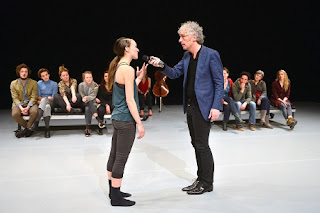Review: "Memory of a Shape"
Choreography: Regina van Berkel
Music: Theo Verbey, Fractal Symphony, Philharmonisch Staatsorchester Mainz o.l.v. Catherine Rüwardt
costumes: Regina van Berkel
stage-setting: Dietmar Janeck
costumes: Merlijn Koopman
On 17th of february I went to see the premiere of "Introdans danst MONUMENTAAL" in the "stadstheater" of Arnhem.
It was a full program with four different choreographys of which I choosed the last piece "Memory of a shape", choreographed by Regina van Berkel.
When I watched the piece I felt the strong expression of the dancers and their movement, wherefore I think it suited to put it as the last piece of the quadrology "MONUMENTAAL".
Reflecting the piece I was thinking about the title "Memory of a Shape" and I realized that this piece offers a lot of how to interpret the word "shape".
First of all I could see different shapes on the stage created by the stage props, which engaged because of their size quite a lot of the space. A lot of white squares put together to sort of towers, who appeared just natural and quite monumental because of their sizes or serving as background for beamed moving squares, who -quite the opposite- appeared lightfull and airy. This material contradiction produced a certian tension that supported al the coming exitement coming through the moving material.
Besides that variety the colours and models of the costumes and lightening from a deep and icy blue over to a sunny and golden yellow ending in a flocked and extravagate costume showed a big range of the possibility og how material shape can transform.
But way more relevant and interesting seem to me, the shape shown with the body.
Observing the dancers I understood why "memory" of a Shape??
When the body moves it always transfers from one shape into another. The new won shape serves as memory of the earlier one, which has been necessary for the new shape. On shape cannot arise without the elder one. Amd these constant switches makes the performance essence out.
But which concrete forms have been showed in which way?
Well, an important role therefore plays also the music.
Because somehow the dancers body were the corporal mirror of what is going on in the music.
Arisement in the melody, high and deep sounds, breaks, accents - all this was transacted into high legs, spectaculare lifts, freezing postures and gestures etc.
In addition it played a huge role if the dancers were movin as individuals, in a duo or doing an unisono movement as a whole group. One simple movement in a group makes the spectator more aware of the shape the choreographer wants to create and the feeling he wants to transmitt. Especially when the dancers additionally stamped the body shape per se won a new dimension and image was more strong.
I have to admitt that I like in general the detail of a movement. Therefore I appreciated the scene I saw, when the whole group was standing in a throng and just moving one shoulder up. Immideatly one of the female dancers was lifted and stayed for a while in the air. So the small lifting shoulder became a memory, presented by the moving dancer in the air .
All in all I have to admit that I have wished to see every movement with more time. There was most of the time going on a lot on stage and in short time... my eyes barely couldn´t decide where to look as the choreography offered so much.
But still I was fascinated to see that kind of river of movements, one shape being transferred into the other and it cleared up for me: shape is not shape, and shape is way more than you think!
Dorothea Mende



















